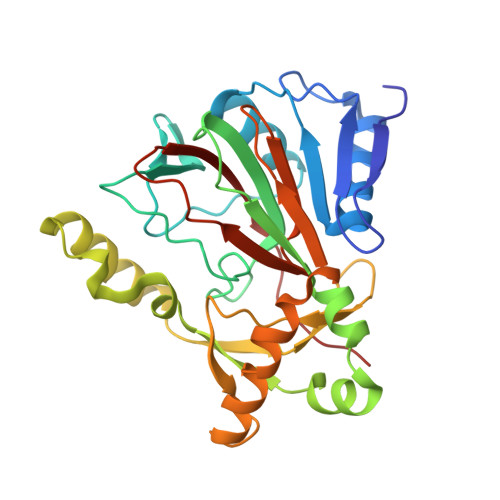Substrate-induced conformational changes in Escherichia coli taurine/alpha-ketoglutarate dioxygenase and insight into the oligomeric structure
O'Brien, J.R., Schuller, D.J., Yang, V.S., Dillard, B.D., Lanzilotta, W.N.(2003) Biochemistry 42: 5547-5554
- PubMed: 12741810
- DOI: https://doi.org/10.1021/bi0341096
- Primary Citation of Related Structures:
1OS7, 1OTJ - PubMed Abstract:
The enzymes in the alpha-ketoglutarate (alphaKG) dependent dioxygenase superfamily represent the largest class of non-heme iron oxidases and have important medical, ecological, and biotechnological roles. One such enzyme, taurine/alpha-ketoglutarate dioxygenase (TauD), catalyzes the conversion of 2-aminoethanesulfonate (taurine) to sulfite and aminoacetaldehyde while decomposing alphaKG to succinate and CO(2). This alphaKG dependent dioxygenase is expressed in Escherichia coli under sulfur starvation conditions and allows the cell to utilize taurine, and other similar sulfonates in the environment, as an alternative sulfur source. In this work, we report the structures of the apo and holo forms of TauD to 1.9 A resolution (R(cryst) = 21.2%, R(free) = 24.9%) and 2.5 A resolution (R(cryst) = 22.5%, R(free) = 27.8%), respectively. The models reported herein provide significant new insight into the substrate orientations at the active site and the conformational changes that are induced upon taurine binding. Furthermore, analysis of our crystallographic data coupled with reanalysis of the crystallographic model (resolution = 3.0 A, R(cryst) = 28.1, R(free) = 32.0) presented by Elkins et al. (Biochemistry (2002) 41, 5185-5192) reveals an alternative oligomeric arrangement for the enzyme that is consistent with the conserved primary and secondary structure elements of other alphaKG dependent dioxygenases.
Organizational Affiliation:
Department of Biochemistry and Molecular Biology, University of Georgia, Athens, Georgia 30602, USA.
















